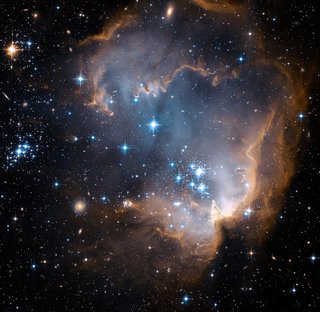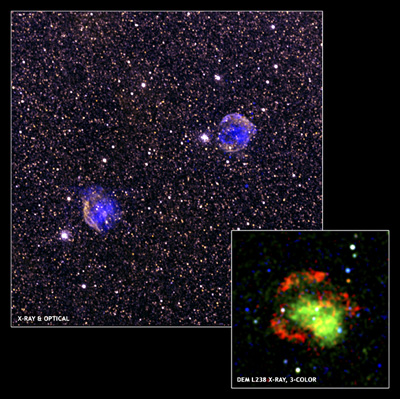Star forming regions

_______________________________________________________
Nearby Galaxy Cluster NGC 602, N90 Credit:Hubblesite
Hubblesite Observes Infant Stars in Nearby Galaxy
Cluster within Star-Forming Region in the Large Magellanic Cloud.
Constellation: Tucana
This new image taken with NASA's Hubble Space Telescope depicts bright, blue, newly formed stars that are blowing a cavity in the center of a star-forming region in the Small Magellanic Cloud. Distance: Approximately 196,000 light-years (61 kiloparsecs). Dimensions: This image is roughy 3 arcminute (180 light-years or 55 parsecs) wide.
[+/-] Click here to expand

_________________________________________________________
Credits: NASA/CXC/NCSU/Borkowski et al. (X-ray); NOAO/AURA/NSF/Points/Smith (optical)
X-ray evidence supports possible new class of supernova
The large image shows a composite of Chandra X-ray data in blue and optical data in white of DEM L238 and DEM L249, two supernova remnants in the Large Magellanic Cloud. The inset reveals how DEM L238 (shown on the right in the wide-field view) appears in the three bands of X-ray emission, where low energy X-rays are shown in red, medium energies in green and high energies in blue. The central region of DEM L238 is green which indicates that it is rich in iron. This overabundance of iron identifies this object as a Type Ia supernova, possibly as a result from the explosion of a much younger star than expected.

Hubble Images Outbursts from Massive Star
These NASA Hubble Space Telescope images show the outflow from one of the brightest hypergiant stars in the sky, VY Canis Majoris.
The image on the left, taken with Hubble's Wide Field and Planetary Camera 2, reveal its complex circumstellar ejecta, with arcs, filaments, and knots of material formed by the massive outflows. This image provided the first evidence that the brightest arcs and knots were created during several outbursts. The random orientations of the arcs also suggested they were produced by localized eruptions from active regions on the star's surface. This is composite picture from separate images taken in blue, green, red, and near-infrared light.
The image at right, taken with the Advanced Camera for Surveys, was made with polarizing filters to show how the dust ejected by the star is distributed in three-dimensional space. The light from the star becomes polarized when it is reflected off the dust. The dust formed around the star and was driven into space. To see the polarized light, astronomers used a polarizing filter, which lets through only light vibrating in one direction and blocks out light vibrating in other directions. Astronomers assembled this picture from separate images taken at three different polarization angles, colored red, green, and blue.
They measured the velocities of the ejecta from spectra obtained with the Keck 10-meter telescope. They also compared the ejecta's expansion taken with Hubble six years apart. These observations showed that the numerous arcs, loops, and knots were moving at different speeds and in various directions, confirming they were produced from separate events and from different locations on the star. The prominent arc to the northwest or upper right in the Hubble image is moving at 102,700 miles an hour (165,600 kilometers an hour), and was ejected about 500 years ago. The knots near the center of the image are traveling at 80,400 miles an hour (129,600 kilometers an hour).
The star, located 5,000 light-years away, is one of the largest and one of the most luminous evolved stars known. It is 500,000 times brighter and about 30 to 40 times more massive than the Sun.

Gas Giants Jump Into Planet Formation Early
This is an artist's concept of a hypothetical 10-million-year-old star system. The bright blur at the center is a star much like our sun. The other orb in the image is a gas-giant planet like Jupiter. Wisps of white throughout the image represent traces of gas.
Astronomers using NASA's Spitzer Space Telescope have found evidence showing that gas-giant planets either form within the first 10 million years of a sun-like star's life, or not at all. The lifespan for sun-like stars is about 10 billion years.
The scientists came to this conclusion after searching for traces of gas around 15 different sun-like stars, most with ages ranging from 3 million to 30 million years. With the help of Spitzer's Infrared Spectrometer instrument, they were able to search for relatively warm gas in the inner regions of these star systems, an area comparable to the zone between Earth and Jupiter in our own solar system. They also used ground-based radio telescopes to search for cooler gas in the outer regions of these systems, an area comparable to the zone around Saturn and beyond.
(Image credit: NASA/JPL-Caltech/T. Pyle (SSC))
_______________________________________________________
_______________________________________________________
Labels: Chandra, hubble, Magellanic Cloud


<< Home